Reign 1502–1520 Name Moctezuma II Siblings Cuitlahuac | Successor Cuitlahuac Father Axayacatl | |
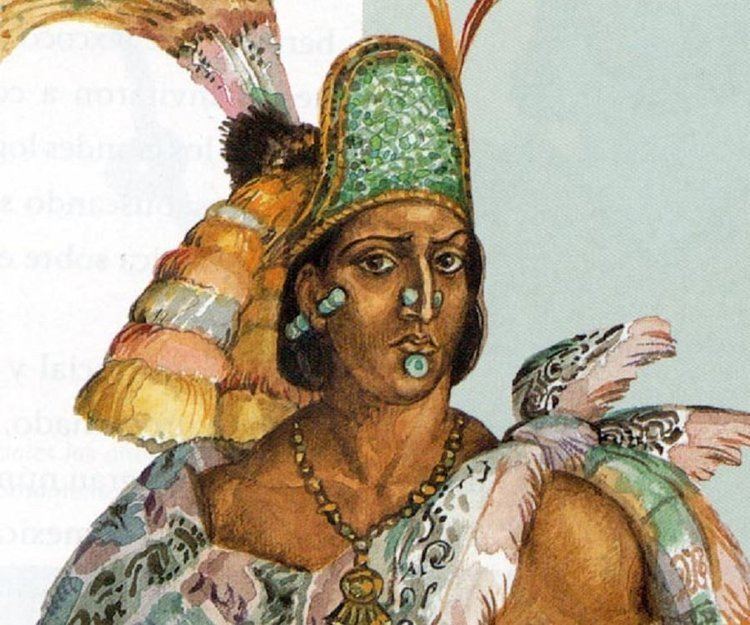 | ||
Consort TeotlalcoTlapalizquixochtzin Issue Isabel MoctezumaAnother daughterChimalpopocaTlaltecatzin Similar People Hernan Cortes, Cuitlahuac, Moctezuma I, La Malinche, Isabel Moctezuma | ||
Grandchildren Leonor Cortes Moctezuma Born c. 1466 (age 53–54) Died June 29, 1520 (aged 53–54) Tenochtitlan, Mexico | ||
Moctezuma ii auge
Moctezuma II (c. 1466 – 29 June 1520), variant spellings include Montezuma, Moteuczoma, Motecuhzoma and referred to in full by early Nahuatl texts as Motecuhzoma Xocoyotzin (Moctezuma the Young, modern Nahuatl pronunciation ), was the ninth tlatoani or ruler of Tenochtitlan, reigning from 1502 to 1520. The first contact between indigenous civilizations of Mesoamerica and Europeans took place during his reign, and he was killed during the initial stages of the Spanish conquest of Mexico, when conquistador Hernán Cortés and his men fought to escape from the Aztec capital Tenochtitlan.
Contents
- Moctezuma ii auge
- Moctezuma ii la ca da
- Family
- Name
- Regnal number
- Bernal Daz del Castillo
- Bernardino de Sahagn
- Hernn Corts
- Fernando Alvarado Tezozmoc
- Depiction in early post conquest literature
- Indigenous accounts of omens and Moctezumas beliefs
- First interactions with the Spanish
- Host and prisoner of the Spaniards
- Death
- Aftermath
- Descendants in Mexico and the Spanish nobility
- Indigenous mythology and folklore
- Symbol of indigenous leadership
- References

During his reign the Aztec Empire reached its greatest size. Through Warfare, Moctezuma expanded the territory as far south as Xoconosco in Chiapas and the Isthmus of Tehuantepec, and incorporated the Zapotec and Yopi people into the empire. He changed the previous meritocratic system of social hierarchy and widened the divide between pipiltin (nobles) and macehualtin (commoners) by prohibiting commoners from working in the royal palaces.
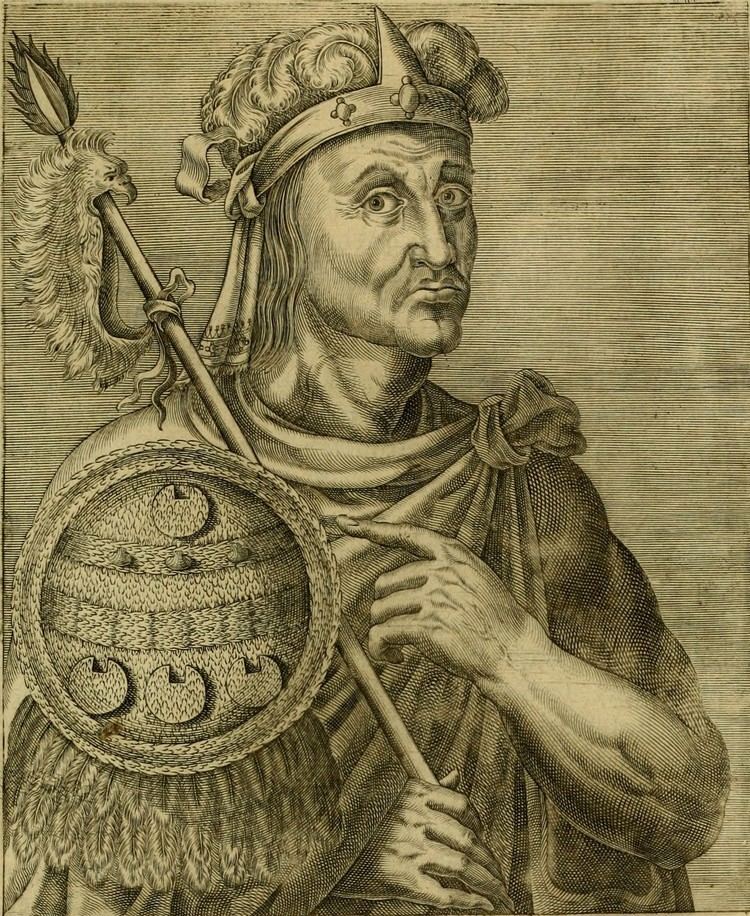
The portrayal of Moctezuma in history has mostly been colored by his role as ruler of a defeated nation, and many sources describe him as weak-willed and indecisive. The biases of some historical sources make it difficult to understand his actions during the Spanish invasion.
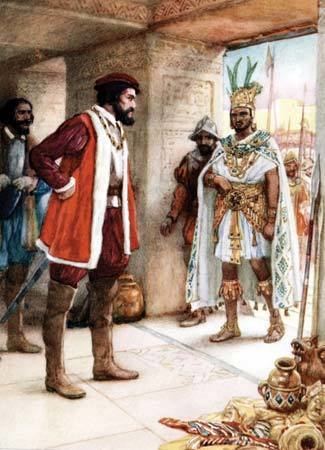
Moctezuma ii la ca da
Family
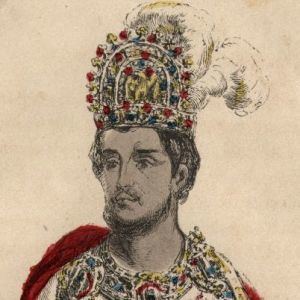
Moctezuma had many wives and concubines but only two women were his Queens – Tlapalizquixochtzin and Teotlalco. He was also a King Consort of Ecatepec because Tlapalizquixochtzin was Queen of that city.
His many children included Princess Isabel Moctezuma — and sons Chimalpopoca (not to be confused with the previous huey tlatoani) and Tlaltecatzin.
Name
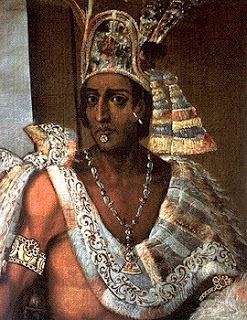
The Nahuatl pronunciation of his name is [motekʷˈsoːma]. It is a compound of a noun meaning "lord" and a verb meaning "to frown in anger", and so is interpreted as "he is one who frowns like a lord" or "he who is angry in a noble manner."
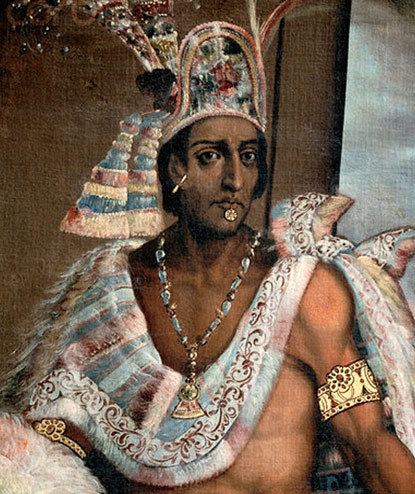
His name glyph, shown in the upper left corner of the image from the Codex Mendoza above, was composed of a diadem (xiuhuitzolli) on straight hair with an attached earspool, a separate nosepiece and a speech scroll.
Regnal number
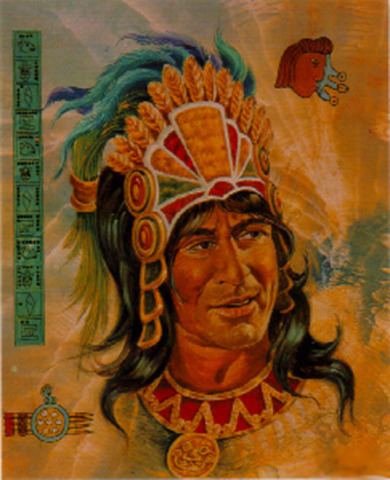
The Aztecs did not use regnal numbers; they were given retroactively by historians to more easily distinguish him from the first Moctezuma, referred to as Moctezuma I. The Aztec chronicles called him Motecuhzoma Xocoyotzin, while the first was called Motecuhzoma Ilhuicamina or Huehuemotecuhzoma ("Old Moctezuma"). Xocoyotzin (IPA: [ʃokoˈjotsin]) means "honored young one" (from "xocoyotl" [younger son] + suffix "-tzin" added to nouns or personal names when speaking about them with deference ).
The descriptions of the life of Moctezuma are full of contradictions, and thus nothing is known for certain about his personality and rule.
Bernal Díaz del Castillo
The firsthand account of Bernal Díaz del Castillo's True History of the Conquest of New Spain paints a portrait of a noble leader who struggles to maintain order in his kingdom after he is taken prisoner by Hernán Cortés. In his first description of Moctezuma, Díaz del Castillo writes:
"The Great Montezuma was about forty years old, of good height, well proportioned, spare and slight, and not very dark, though of the usual Indian complexion. He did not wear his hair long but just over his ears, and he had a short black beard, well-shaped and thin. His face was rather long and cheerful, he had fine eyes, and in his appearance and manner could express geniality or, when necessary, a serious composure. He was very neat and clean, and took a bath every afternoon. He had many women as his mistresses, the daughters of chieftains, but two legitimate wives who were Caciques in their own right, and only some of his servants knew of it. He was quite free from sodomy. The clothes he wore one day he did not wear again till three or four days later. He had a guard of two hundred chieftains lodged in rooms beside his own, only some of whom were permitted to speak to him." (Díaz del Castillo 1568/1963: 224–25)
When Moctezuma was allegedly killed by being stoned to death by his own people "Cortés and all of us captains and soldiers wept for him, and there was no one among us that knew him and had dealings with him who did not mourn him as if he were our father, which was not surprising, since he was so good. It was stated that he had reigned for seventeen years, and was the best king they ever had in Mexico, and that he had personally triumphed in three wars against countries he had subjugated. I have spoken of the sorrow we all felt when we saw that Montezuma was dead. We even blamed the Mercederian friar for not having persuaded him to become a Christian." (Díaz del Castillo 1568/1963: 294)
Bernardino de Sahagún
The Florentine Codex, made by Bernardino de Sahagún, relied on native informants from Tlatelolco, and generally portrays Tlatelolco and Tlatelolcan rulers in a favorable light relative to those of Tenochtitlan. Moctezuma in particular is depicted unfavorably as a weak-willed, superstitious, and indulgent ruler (Restall 2003). Historian James Lockhart suggests that the people needed to have a scapegoat for the Aztec defeat, and Moctezuma naturally fell into that role.
Hernán Cortés
Unlike Bernal Díaz, who was recording his memories many years after the fact, Cortés wrote his Cartas de relación (Letters from Mexico) to justify his actions to the Spanish Crown. His prose is characterized by simple descriptions and explanations, along with frequent personal addresses to the King. In his Second Letter, Cortés describes his first encounter with Moctezuma thus:
Mutezuma [sic] came to greet us and with him some two hundred lords, all barefoot and dressed in a different costume, but also very rich in their way and more so than the others. They came in two columns, pressed very close to the walls of the street, which is very wide and beautiful and so straight that you can see from one end to the other. Mutezuma came down the middle of this street with two chiefs, one on his right hand and the other on his left. And they were all dressed alike except that Mutezuma wore sandals whereas the others went barefoot; and they held his arm on either side. (Translation: Anthony Pagden 1986:84)
Anthony Pagden and Eulalia Guzmán (Relaciones de Hernán Cortés 1958:279) have pointed the Biblical messages that Cortés seems to ascribe to Moctezuma's retelling of the legend of Quetzalcoatl as a vengeful Messiah who would return to rule over the Mexica. Pagden has written that "There is no preconquest tradition which places Quetzalcoatl in this role, and it seems possible therefore that it was elaborated by Sahagún and Motolinía from informants who themselves had partially lost contact with their traditional tribal histories" (Pagden 1986:467)
Fernando Alvarado Tezozómoc
Fernando Alvarado Tezozómoc, who wrote the Crónica Mexicayotl, was a grandson of Moctezuma II and his chronicle mostly relates the genealogy of the Aztec rulers. He describes Moctezuma's issue and counts that Moctezuma had nineteen children – eleven sons and eight daughters.
Depiction in early post-conquest literature
Some of the Aztec stories about Moctezuma describe him as being fearful of the Spanish newcomers, and some sources, such as the Florentine Codex, comment that the Aztecs believed the Spaniards to be gods and Cortés to be the returned god Quetzalcoatl. The veracity of this claim is difficult to ascertain, though some recent ethnohistorians specialising in early Spanish/Nahua relations have discarded it as post-conquest mythicalisation.
Much of the idea of Cortés being seen as a deity can be traced back to the Florentine Codex, written some 50 years after the conquest. In the codex's description of the first meeting between Moctezuma and Cortés, the Aztec ruler is described as giving a prepared speech in classical oratorial Nahuatl, a speech which as described verbatim in the codex (written by Sahagún's Tlatelolcan informants) included such prostrate declarations of divine or near-divine admiration as, "You have graciously come on earth, you have graciously approached your water, your high place of Mexico, you have come down to your mat, your throne, which I have briefly kept for you, I who used to keep it for you," and, "You have graciously arrived, you have known pain, you have known weariness, now come on earth, take your rest, enter into your palace, rest your limbs; may our lords come on earth." While some historians such as Warren H. Carroll consider this as evidence that Moctezuma was at least open to the possibility that the Spaniards were divinely sent based on the Quetzalcoatl legend, others such as Matthew Restall argue that Moctezuma politely offering his throne to Cortés (if indeed he did ever give the speech as reported) may well have been meant as the exact opposite of what it was taken to mean, as politeness in Aztec culture was a way to assert dominance and show superiority. Other parties have also propagated the idea that the Native Americans believed the conquistadors to be gods, most notably the historians of the Franciscan order such as Fray Gerónimo de Mendieta. Bernardino de Sahagún, who compiled the Florentine Codex, was also a Franciscan priest.
Indigenous accounts of omens and Moctezuma's beliefs
Bernardino de Sahagún (1499–1590) includes in Book 12 of the Florentine Codex eight events said to have occurred prior to the arrival of the Spanish. These were purportedly interpreted as signs of a possible disaster, e.g. a comet, the burning of a temple, a crying ghostly woman, and others. Some speculate that the Aztecs were particularly susceptible to such ideas of doom and disaster because the particular year in which the Spanish arrived coincided with a "tying of years" ceremony at the end of a 52-year cycle in the Aztec Calendar, which in Aztec belief was linked to changes, rebirth and dangerous events. The belief of the Aztecs being rendered passive by their own superstition is referred to by Matthew Restall as part of "The Myth of Native Desolation" to which he dedicates chapter 6 in his book Seven Myths of the Spanish Conquest. These legends are likely a part of the post-conquest rationalization by the Aztecs of their defeat, and serve to show Moctezuma as indecisive, vain, and superstitious, and ultimately the cause of the fall of the Aztec Empire.
Ethnohistorian Susan Gillespie has argued that the Nahua understanding of history as repeating itself in cycles also led to a subsequent rationalization of the events of the conquests. In this interpretation the description of Moctezuma, the final ruler of the Aztec Empire prior to the Spanish conquest, was tailored to fit the role of earlier rulers of ending dynasties—for example Quetzalcoatl, the mythical last ruler of the Toltecs. In any case it is within the realm of possibility that the description of Moctezuma in post-conquest sources was colored by his role as a monumental closing figure of Aztec history.
First interactions with the Spanish
In 1517, Moctezuma received the first reports of Europeans landing on the east coast of his empire; this was the expedition of Juan de Grijalva who had landed on San Juan de Ulúa, which although within Totonac territory was under the auspices of the Aztec Empire. Moctezuma ordered that he be kept informed of any new sightings of foreigners at the coast and posted extra watch guards to accomplish this. (Díaz del Castillo 1963: 220).
When Cortés arrived in 1519, Moctezuma was immediately informed and he sent emissaries to meet the newcomers; one of them known to be an Aztec noble named Tentlil in the Nahuatl language but referred to in the writings of Cortés and Bernal Díaz del Castillo as "Tendile". As the Spaniards approached Tenochtitlan they made an alliance with the Tlaxcalteca, who were enemies of the Aztec Triple Alliance, and they helped instigate revolt in many towns under Aztec dominion. Moctezuma was aware of this and he sent gifts to the Spaniards, probably in order to show his superiority to the Spaniards and Tlaxcalteca.
On 8 November 1519, Moctezuma met Cortés on the causeway leading into Tenochtitlan and the two leaders exchanged gifts. Moctezuma gave Cortés the gift of an Aztec calendar, one disc of crafted gold and another of silver. Cortés later melted these down for their material value (Díaz del Castillo 1963: 216–19).
Host and prisoner of the Spaniards
Moctezuma brought Cortés to his palace where the Spaniards lived as his guests for several months. Moctezuma continued to govern his empire and even undertook conquests of new territory during the Spaniards' stay at Tenochtitlan.
At some time during that period Moctezuma became a prisoner in his own house. Exactly why this happened is not clear from the extant sources. The Aztec nobility reportedly became increasingly displeased with the large Spanish army staying in Tenochtitlan, and Moctezuma told Cortés that it would be best if they left. Shortly thereafter Cortés left to fight Pánfilo de Narváez. During his absence, tensions between Spaniards and Aztecs exploded into the Massacre in the Great Temple, and Moctezuma became a hostage used by the Spaniards to assure their security.
Death
In the subsequent battles with the Spaniards after Cortés' return, Moctezuma was killed. The details of his death are unknown, with different versions of his demise given by different sources.
In his Historia, Bernal Díaz del Castillo states that on 1 July 1520, the Spanish forced Moctezuma to appear on the balcony of his palace, appealing to his countrymen to retreat. The people were appalled by their emperor's complicity and pelted him with rocks and darts. He died a short time after that. Bernal Díaz gives this account:
"Barely was the emperor's speech to his subjects finished when a sudden shower of stones and darts descended. Our men who had been shielding Montezuma had momentarily neglected their duty when they saw the attack cease while he spoke to his chiefs. Montezuma was hit by three stones, one on the head, one on the arm, and one on the leg; and though they begged him to have his wounds dressed and eat some food and spoke very kindly to him, he refused. Then quite unexpectedly we were told that he was dead."
Cortés similarly reported that Moctezuma was stabbed by his countrymen. On the other hand, the indigenous accounts claim that he was killed by the Spanish prior to their leaving the city.
Franciscan friar Bernardino de Sahagún recorded two versions of the conquest of Mexico from the Tenochtitlan-Tlatelolco viewpoint. In Book 12 of the twelve-volume Florentine Codex the account in Spanish and Nahuatl is accompanied by illustrations by natives. One is of the death of Moctezuma II, which the indigenous assert was due to the Spaniards. According to the Codex the bodies of Moctezuma and Itzquauhtzin were cast out of the Palace by the Spanish; the body of Moctezuma was gathered up and cremated at Copulco.
Aftermath
The Spaniards were forced to flee the city and they took refuge in Tlaxcala, and signed a treaty with them to conquer Tenochtitlan, offering to the Tlaxcalans freedom from any kind of tribute and the control of Tenochtitlan.
Moctezuma was then succeeded by his brother Cuitláhuac, who died shortly after during a smallpox epidemic. He was succeeded by his adolescent nephew, Cuauhtémoc. During the siege of the city, the sons of Moctezuma were murdered by the Aztecs, possibly because they wanted to surrender. By the following year, the Aztec empire had fallen to an army of Spanish and their Indian allies, primarily Tlaxcalans who were traditional enemies of the Aztecs.
Following the conquest, Moctezuma's daughter Techichpotzin (or Tecuichpoch) became known as Isabel Moctezuma. She was given a large estate by Cortés, who also fathered a child by her, Leonor Cortés Moctezuma. Isabel was married and widowed by a conquistador in Cortés's original group, Alonso Grado (died. ca. 1527) and poblador (a Spaniard who had arrived after the fall of Tenochtitlan), Pedro Gallego (died ca. 1531), and conquistador Juan Cano, who survived her.
Descendants in Mexico and the Spanish nobility
Moctezuma had many wives and concubines by whom he fathered an enormous family. Though the exact number of his children is unknown and the names of most of his children were lost to history, according to a Spanish chronicler, by the time he was taken captive, Moctezuma had fathered 100 children (including dozens of sons) and fifty of his wives and concubines were then in some stage of pregnancy, though this estimate may have been exaggerated. As Aztec culture made class distinctions between the children of senior wives, lesser wives, and concubines, not all of his children were considered equal in nobility or inheritance rights.
Of his many wives may be named the princesses Teitlalco, Acatlan, and Miahuaxochitl, of whom the first named appears to have been the only legitimate consort. By her he left a son, Asupacaci, who fell during the Noche Triste, and a daughter, Tecuichpo, baptized as Isabel, married consecutively to Cuauhtemoc (the last Mexican sovereign), to visitador general Alonso Grado, to Pedro Andrade Gallego, and to Juan Cano de Saavedra. She had children by the latter two, from whom descend the illustrious families of Andrade-Montezuma and Cano-Montezuma. By the Princess Acatlan were left two daughters, baptized as Maria and Marina (also known as Leonor). The latter alone left offspring, from whom descends the Sotelo-Montezuma family.
Several lines of descendants exist in Mexico and Spain through Moctezuma II's son and daughters, notably Tlacahuepan Ihualicahuaca, or Pedro Moctezuma and Tecuichpoch Ixcaxochitzin, or Isabel Moctezuma.
The grandson of Moctezuma II, Pedro's son, Ihuitemotzin, baptized as Diego Luis de Moctezuma, was brought to Spain by King Philip II. There he married Francisca de la Cueva de Valenzuela. In 1627, their son Pedro Tesifón de Moctezuma was given the title Count of Moctezuma (later altered to Moctezuma de Tultengo), and thus became part of the Spanish nobility. In 1766, the holder of the title became a Grandee of Spain. In 1865 (coincidentally during the Second Mexican Empire) the title, which was held by Antonio María Moctezuma-Marcilla de Teruel y Navarro, 14th Count of Moctezuma de Tultengo, was elevated to that of a Duke, thus becoming Duke of Moctezuma, with de Tultengo again added in 1992 by Juan Carlos I.
Descendants of Pedro Tesifón de Moctezuma included (through an illegitimate child of his son Diego Luis) General Jerónimo Girón-Moctezuma, 3rd Marquis de las Amarilas (1741-1819), a 9th generation descendant of Moctezuma II, who was commander of the Spanish forces at the Battle of Fort Charlotte, and his grandson, Francisco Javier Girón y Ezpeleta, 2nd es:Ducado de Ahumada and 5th marqués de las Amarillas who was the founder of the Guardia Civil in Spain.
Other holders of Spanish noble titles that descend from the Aztec emperor include Dukes of Atrisco.
Isabel Moctezuma was by Hernán Cortés the mother of Leonor Cortés Moctezuma who was the mother of Isabel de Tolosa Cortés de Moctezuma.
A nephew of Moctezuma II was Diego de Alvarado Huanitzin.
Indigenous mythology and folklore
Many Indigenous peoples in Mexico are reported to worship deities named after the Aztec ruler, and often a part of the myth is that someday the deified Moctezuma shall return to vindicate his people. In Mexico, the contemporary Pames, the Otomi, Tepehuán, Totonac ,and Nahua peoples are reported to worship earth deities named after Moctezuma. His name also appears in Tzotzil Maya ritual in Zinacantán where dancers dressed as a rain god are called "Moctezumas"
Hubert Howe Bancroft, writing in the 19th century (Native Races, Volume #3), speculated that the name of the historical Aztec Emperor Moctezuma had been used to refer to a combination of different cultural heroes who were united under the name of a particularly salient representative of Mesoamerican identity.
Symbol of indigenous leadership
As a symbol of resistance towards Spanish the name of Moctezuma has been invoked in several indigenous rebellions.
One such example was the rebellion of the Virgin Cult in Chiapas in 1721, where the followers of the Virgin Mary rebelled against the Spanish after having been told by an apparition of the virgin that Moctezuma would be resuscitated to assist them against their Spanish oppressors. In the Quisteil rebellion of the Yucatec Maya in 1761 the rebel leader Jacinto Canek reportedly called himself "Little Montezuma".
